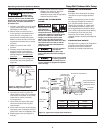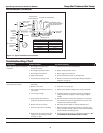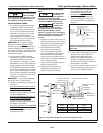
2
Operating Instructions and Parts Manual Deep Well Submersible Pump
www.waynepumps.com
General Safety
Information (Continued)
NOTE: See Installation Wiring Diagrams
for typical wiring hookups and control
box identification.
Fuse Size
HP Volts Standard Dual Elem.
1/2 230 20 10
3/4 230 25 5
1 230 30 20
Table 1 - Recommended fusing data
for 60 Hz, single phase, 3-WIRE
submersible pump/motor
Fuse Size
HP Volts Standard Dual Elem.
1/2 230 20 10
3/4 230 25 5
1 230 30 20
Table 2 - Recommended fusing data
for 60 Hz, single phase, 2-WIRE
submersible pump/motor
WIRING INSTALLATION
Single Phase, 3 Wire
Hazardous voltage! The
electrical system in this pump
CAN cause electrical shock
and death. Permanently ground control
box, metal plumbing, and motor frame
in accordance with national and local
codes. Use copper grounding wire with
a diameter no less than wires carrying
current to motor.
1. At well head, connect grounding
wire to grounding terminal.
Grounding system must meet
all applicable national and
local electrical codes. For more
information, contact local code
officials.
2. Permanently close all unused
openings in this and other
equipment. Disconnect power
before working on or around control
box, pipes, cable, pump, or motor.
3. Install control box vertically on wall
with top side up.
NOTE: Three-wire pumps have three
power supply wires (Red/Black/Yellow)
and one ground wire (Green). When
operated without a control box, three-
wire pumps will not operate properly
and will likely cause motor to burn out.
12. Use wire of adequate size to
minimize voltage drop at the motor.
13. Pipe joint compound can cause
cracking in plastics. Use only
plumbers seal tape when sealing
threaded joints in plastic pipe
or when connecting pipe to
thermoplastic pumps.
Do NOT handle
pump or pump
motor with wet hands, when standing
on a wet or damp surface or when
standing in water. Fatal electrical shock
COULD occur!
Pump motor is
equipped with an
automatic resetting thermal protector
and MAY restart unexpectedly. Protector
tripping is an indication of motor
overloading because of operating
pump at low heads (low discharge
restriction), excessively high or low
voltage, inadequate wiring, incorrect
motor connections, inadequate cooling
or defective motor or pump.
Pre-Installation
1. Inspect pump and motor for delivery
damage.
2. Before installing pump, remove
all fine sand particles and foreign
matter. See Initial Startup section (on
page 4) for more information.
3. Install pump at least 15-20 feet
below the lowest water level
reached with pump running (lowest
drawn-down water level), and at
least 5 feet above bottom of well.
To maximize performance, pump should
process only cold water that is clear and
free of entrained air.
Warranty is void if (1) system pumps
excessive sand resulting in early
pump wear, (2) water is corrosive, (3)
entrained gas or air causes reduced flow
and cavitation, or (4) pump operates
with discharge valve closed, resulting in
serious damage.
Electrical System
WIRING/GROUNDING
Hazardous voltage! The
electrical system in this
pump can cause electrical
shock and death. Permanently ground
pump, motor and control box before
connecting to electrical supply. Ground
pump and motor in accordance with all
codes and ordinances that apply. Use
copper grounding wire with a diameter
no less than wires carrying current to
motor.
1. Permanently ground pump, motor
and control box before connecting
power cable to power supply.
Connect ground wire to approved
ground first, and then connect to
equipment being installed.
2. Motor is supplied with copper
grounding wire. Splice wire to
copper conductor that matches wire
size shown in Table 3, on page 3. See
Wire Splicing under Installation, on
page 4.
Do NOT ground to
gas supply line.
Fire, explosion,
and death or serious injury COULD
result.
Fire and electrical
shock hazard! If
using a power
supply wire larger than No. 10 (5 mm
2
)
between pump and control box, run
wire to separate junction box. Connect
junction box to control box with a No.
10 (5 mm
2
) wire.
For more information, contact your
local code officials.
WIRING CONNECTIONS
All wiring must meet National Electrical
Code requirements, as well as local code
requirements.
Use only copper wiring for connections
to pump and control box.
To prevent wire overheating and
excessive voltage drop at motor, use
wire size at least as large as size shown
in Table 3 on page 3 (based on HP and
length of wire run).


















